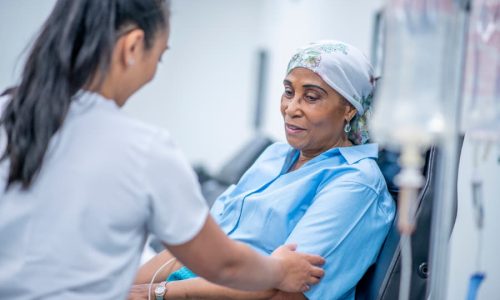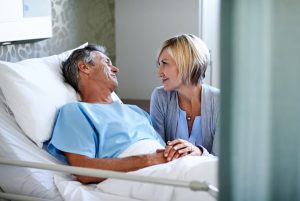
How Does Physical Therapy Help After a Mastectomy?
Physical therapy is well known for its role in helping patients recover from sports injuries, surgeries, and orthopedic conditions. Many people may not realize that
HIPAA Alert: Potential Data Breach Learn More
Questions on Oncology, Hematology and/or Infusion Clinical Services due to COVID-19 Crisis – CALL 833-698-1623
Important Information for Our Patients Regarding the Coronavirus.
RCCA Providing Area Cancer Patients with Access to Care During Coronavirus Outbreak
RCCA Offering Patients Virtual Visits During Coronavirus Pandemic
Patients with cancer understandably may be apprehensive about chemotherapy because of its association with significant side effects. While it is true that some patients do experience debilitating side effects from chemotherapy, advances in medicine enable many patients to tolerate the treatment with modest, minimal, or no side effects.
It is important for patients with cancer who are considering chemotherapy to understand how this mode of treatment works, as well as your risk of an adverse event, so that you can work with your hematologist or oncologist to make an educated decision before proceeding with treatment. The following information from Regional Cancer Care Associates (RCCA) will help you separate the myths from the facts regarding chemotherapy side effects.

Chemotherapy, or chemo, is one of the most common kinds of cancer treatment. Chemotherapy uses powerful medications to attack and kill cancer cells or prevent them from spreading. By reducing the size of tumors, these drugs may also alleviate pain and other symptoms. Chemotherapy also is used to:
As referenced above, chemotherapy often is used in conjunction with other cancer treatments, such as surgery, radiation, and immunotherapy as part of a comprehensive approach to obtaining the best outcomes possible for a patient.
While many people believe that chemotherapy is solely an intravenous treatment, it can also be administered orally in pill or tablet form. Topical formulations of chemotherapy also are used for some skin cancers.
Chemotherapy works by killing cancer cells and preventing them from spreading. However, as chemotherapy drugs target the cancerous cells, they can also kill the healthy cells. Normal cells generally recover from the effects of chemo, while the cancerous cells do not.
Chemo generally is given on a daily, weekly, or monthly schedule, with breaks between each dose to give the body time to recover from side effects. The medical team will determine a schedule and dosing that is best for each patient’s specific case.
There are several types of chemotherapy drugs, each of which work differently. Knowing how each drug works is key to predicting and minimizing its potential side effects. Medical oncologists and hematologists work with their patients to determine the right drug based on each patient’s cancer type, stage, and overall health.
The different types of chemotherapy include:
Alkylating agents prevent cancer cells them from reproducing by damaging their DNA. They can be used to treat many different cancers, including lung, breast, and ovarian cancers as well as leukemia. Gastrointestinal side effects such as stomach pain, diarrhea, vomiting, and nausea can occur from alkylating agents.
Nitrosoureas are alkylating agents that travel into the brain through the blood-brain barrier. This makes them suitable for treating certain brain tumors. Side effects include nausea, vomiting, and headaches.
Antimetabolites prevent cancer cells from reproducing by interfering with the DNA and RNA building blocks of those cells. They are suitable for treating breast and ovarian cancers, leukemias, and similar diseases. Some side effects include nausea, vomiting, fatigue, and diarrhea.
Antitumor antibiotics change the DNA inside cancer cells to keep them from growing and multiplying. These agents are often used to treat leukemia and lymphoma, as well as cancers of the breast, bladder, ovaries, and lungs. Some patients experience fever, vomiting, diarrhea, and nausea from these antibiotics.
Anthracyclines are commonly prescribed antitumor antibiotics that target the enzymes involved in copying DNA during the cell cycle. These drugs can cause permanent heart damage when given in high doses, so the dose usually is limited.
Topoisomerase inhibitors, also known as plant alkaloids, prevent the replication of cancer cells by blocking enzymes from interacting with DNA. These agents help treat leukemias and lung, ovarian, colorectal, pancreatic, and gastrointestinal cancers. Side effects include fatigue, anemia, and infections.
Mitotic inhibitors are derived from plants and work by stopping cancer cells from dividing and forming new cells. They can be used for treating breast and lung cancers, lymphomas, and leukemias. Side effects include nausea, fatigue, and hair loss.
Because chemotherapy kills normal cells along with the cancer cells, side effects can result. Common adverse effects of chemotherapy include:
While some patients report one, two, or even several side effects of chemotherapy, others experience no noticeable problems. Similarly, the intensity and duration of a given side effect can vary considerably based on factors including the drug involved, its dose and frequency of administration, and the patient’s overall health, genetic makeup, and any other conditions the person may have.
Although chemotherapy often is associated with bothersome side effects, these side effects are not always as common as people may believe. Chemotherapy also has evolved significantly over the last few decades. Medical advances have helped reduce the side effects of chemo drugs and have made them more tolerable for most patients.
Still, chemotherapy has a bad reputation for causing troublesome side effects, such as:
When chemotherapy drugs first came into widespread use some 80 years ago, they caused intense nausea and vomiting. Newer chemo drugs, however, have been formulated to reduce upper gastrointestinal (GI) effects.
Additionally, an anti-nausea medication (called an ”antiemetic”) can be taken before chemotherapy begins to further reduce upper GI risk. The care team also can share strategies in terms of when and what to eat before and after chemo sessions that can help make treatment better tolerated.
Many people worry about “going bald” from chemotherapy, as hair loss is one of the more notorious side effects. This happens because many chemo drugs target cells that grow rapidly – a trait that cancer cells and hair follicles have in common. The chemo damages hair follicles, resulting in hair loss.
Not every patient experiences hair loss from chemo. Also, certain chemo drugs carry a higher risk of hair loss than others, and that risk varies depending on the dose and frequency of the medication.
When a follicle-damaging chemo drug is being used, patients often will wear a scalp cooling cap during treatment to help them retain at least some hair. The cooling cap is worn on the scalp to reduce underlying blood flow; this theoretically lowers the amount of chemo that reaches the follicles.
Fatigue is a common side effect of chemotherapy, but it is not always as debilitating as some may think. Most patients continue to work and perform daily activities while undergoing chemotherapy. Also, oncologists and hematologists can adjust the chemo dosage and frequency to help reduce or prevent fatigue and tiredness.
Chemotherapy itself should not be painful. However, some patients will experience neuropathy, nerve damage – usually temporary – that can cause a loss of sensation or, in some cases, a “pins and needles” or tingling sensation that some patients find painful. Repeated vomiting or bouts of diarrhea also can cause discomfort. Patients should promptly report any pain or discomfort to their care team, which often will be able to suggest practical strategies that will help.
Fact: Some, but not all, chemotherapy treatments can cause infertility, so while some patients become infertile, many do not. While they are completing a chemotherapy treatment regimen, many reproductive-aged women will experience interruptions in their menstrual cycles, which obviously can affect fertility, but this effect usually persists only during treatment.
Men and women who are older or on higher doses of chemotherapy are more likely to experience permanent changes to their fertility compared with younger patients on lower-dose chemotherapy.
If a chemotherapy recipient wants to start a family, steps can be taken to preserve fertility before chemo begins, such as through egg retrieval and sperm storage.
As with any treatment, the hematologist or oncologist will discuss the risks and benefits associated with the prescribed chemotherapy agent (or, in some cases, multiple agents). The patient can decide in collaboration with the hematologist/oncologist whether to proceed based on that discussion.
In particular, the hematologist/oncologist will discuss the potential side effects of the chemotherapy, and will explain which side effects warrant prompt medical attention. More serious chemo side effects that may require treatment include a high fever, an allergic reaction, unusual pain, shortness of breath, or bloody stool or urine.
As noted earlier, chemotherapy often is used in conjunction with other forms of therapy as part of a comprehensive treatment plan. In other cases, chemotherapy is not a good option for a patient because of his overall health or the nature of her cancer. Cancer treatment approaches frequently employed before, during, after, or instead of chemotherapy treatment include:
Radiation therapy uses high-energy rays to kill cancer cells and prevent their spread. Patients may undergo external or internal radiation or receive radioactive medications. Radiation often is used to treat cancers of the head and neck, breast, liver, and prostate.
Immunotherapy enhances the body’s immune system, empowering it to recognize and destroy cancer cells.
Examples of immunotherapy include monoclonal antibodies and checkpoint inhibitors, among others. Immunotherapies are used to treat both blood-based malignancies and solid tumors, including leukemia, lymphoma and kidney, lung, skin, and prostate cancers, among others.
Like chemotherapy, targeted therapy uses drugs to attack cancer cells or disrupt their function and reproduction. However, these medications specifically affect malignant cells – typically by binding to receptors on their surface – while leaving healthy cells intact.
Targeted therapies are used to treat breast, lung cancer, colorectal, and skin cancers, among other malignancies.
Surgery is a common approach to treating patients with cancer, in particular cancers of the breast, colon, lung, skin, and prostate. The location, type and stage of cancer determines the type of surgery performed.
Hormone therapy helps suppress or disrupt the body’s ability to make the hormones that feed certain cancers.
Hormone therapy can be administered through injections, pills, and other methods.
What types of cancer is chemotherapy best for?
Chemotherapy is used for treating many types of cancer, including leukemia, lymphoma, Hodgkin lymphoma, brain cancer, lung cancer, breast cancer, prostate cancer, and ovarian cancer.
What is the success rate of chemotherapy?
Because many patients receive chemotherapy alongside other treatments, it is difficult to determine the success rates for chemotherapy alone. Chemo success also depends on the cancer’s type and stage, the specific type of therapy administered, and the patient’s age and overall health. The definition of “success” also varies based on the cancer and person’s circumstances. When a cancer that is generally responsive to treatment is diagnosed in its early stages, the goal of treatment often is cure. By contrast, when a cancer has metastasized to distant areas of the body, the goal generally is to prolong life while maintaining quality of life. In the latter case, chemotherapy can help both by containing or slowing the spread of cancer and shrinking tumors that might be causing pain or interfering with function by pressing on nerves or other organs.
Is chemotherapy always the preferred cancer treatment?
No. While chemotherapy is effective, it is not always the best treatment for some cancer types and stages. Further, some patients may not tolerate chemotherapy. Some patients may be better served by receiving other treatments – such as radiation, surgery, or targeted therapy – either alone or in combination with chemo.
How can a patient tell if chemotherapy is working?
Medical oncologists use blood tests, imaging, and other means, to assess the impact of chemotherapy. Blood tests show the levels of certain hormones, proteins, and enzymes to provide insights into the effectiveness of the chemo. Imaging can show whether tumors have spread, decreased, or multiplied.
Is chemotherapy painful?
Chemotherapy itself should not be painful. If a patient experiences pain, it will typically occur after the fact due to the side effects of chemotherapy. There are ways to help manage side effects and pain from chemotherapy.
How often is chemotherapy given?
Chemotherapy frequency depends on each patient’s cancer type and stage, and on the specific chemo drug used.
When should a doctor be contacted about chemotherapy side effects?
Every patient’s medical team should discuss the expected side effects of the patient’s chemotherapy and which situations warrant a call to the doctor. More serious chemo side effects that may require prompt medical attention include a high fever, unusual pain, shortness of breath, or bloody stool or urine.
RCCA’s expert hematologists and oncologists offer chemotherapy and other cutting-edge, evidence-based cancer treatments at 22 community-based, conveniently located treatment centers throughout New Jersey, Connecticut, Massachusetts, and the Washington, D.C., area.
RCCA oncologists and hematologists see more than 26,000 new patients each year and provide care to more than 245,000 established patients, collaborating closely with their patients’ other physicians. RCCA care teams also offer their patients:
If you’re grappling with a cancer diagnosis or need a second opinion, request an appointment today to learn about your treatment options.
For more information or to schedule an appointment,
call 844-346-7222. You can also schedule an appointment by calling the RCCA location nearest you.

Physical therapy is well known for its role in helping patients recover from sports injuries, surgeries, and orthopedic conditions. Many people may not realize that

Colon cancer is often treated with surgery, which can have a long recovery period. When patients understand what to expect, they feel more confident about

Routine screening is an individual’s first line of defense against colon cancer. Many people have the freedom to choose which type of screening to undergo,

Regional Cancer Care Associates is one of fewer than 200 medical practices in the country selected to participate in the Oncology Care Model (OCM); a recent Medicare initiative aimed at improving care coordination and access to and quality of care for Medicare beneficiaries undergoing chemotherapy treatment.